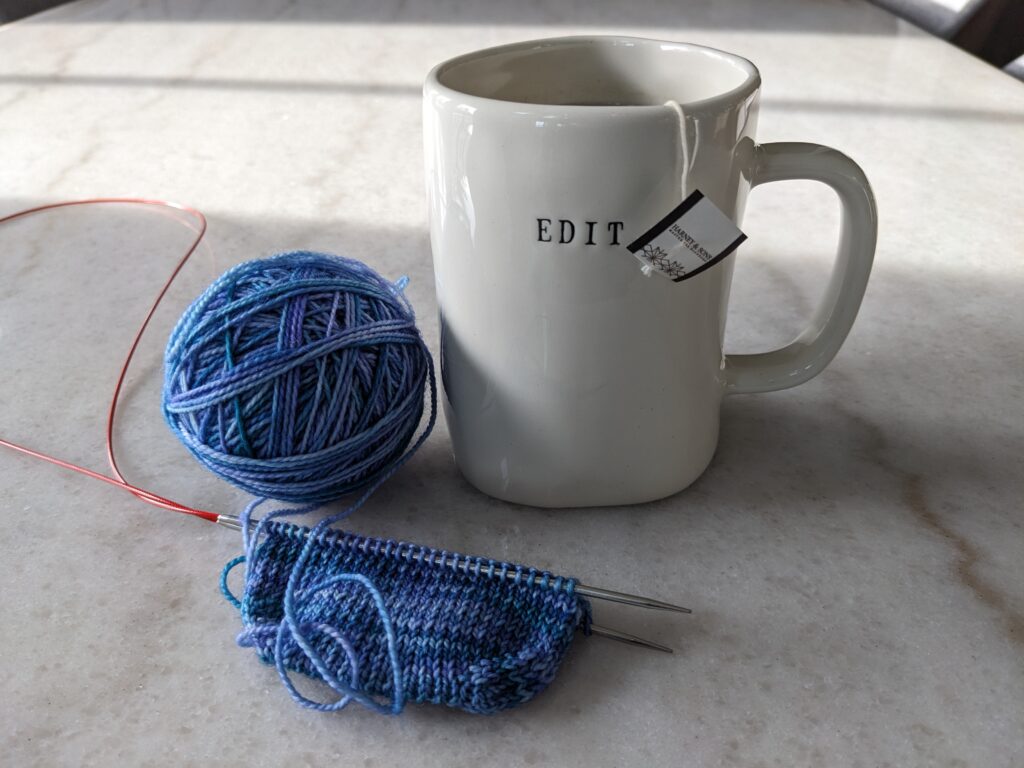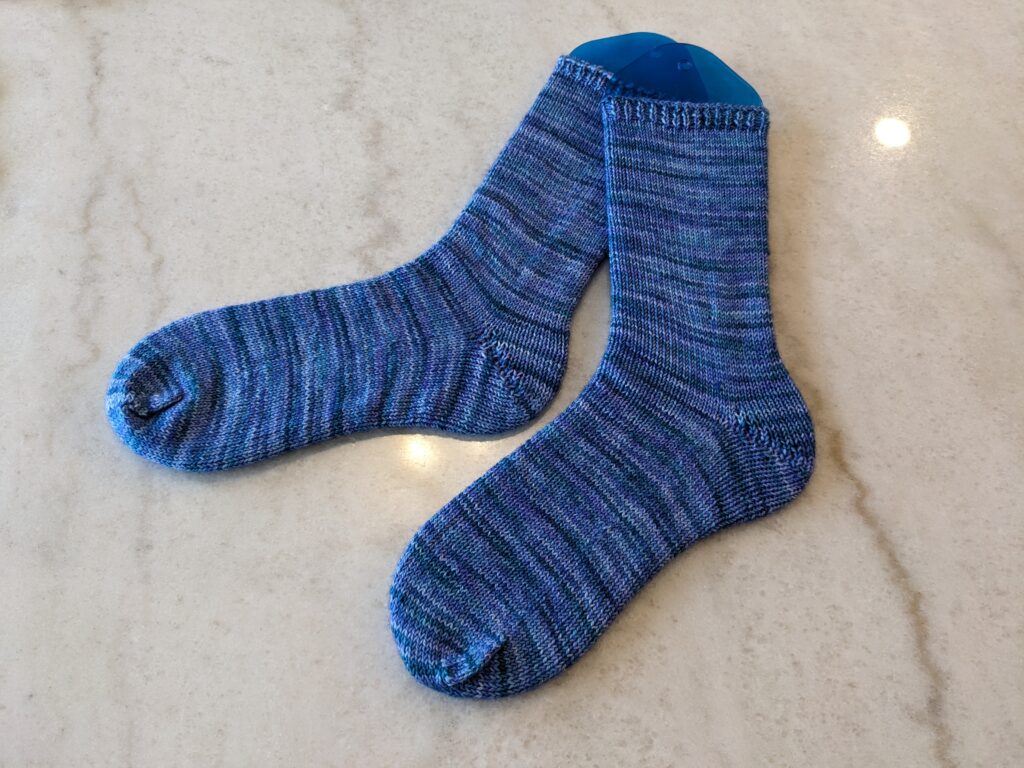
By Meagan Lucas
I hate it when editors publish themselves—especially in anthologies, but that’s another column—and I vowed when I started this mag that I wasn’t going to do that. But then I had an idea for this essay, and I thought a craft column isn’t as self-indulgent as publishing my own fiction, right? Plus, I knew if I told my friend and the editor of Wind & Root, Charlotte Hamrick, that I wanted to write this essay that she would encourage me, and give me a deadline, and that I would be too embarrassed to miss that deadline, or quit and let her down, so I would have to finish this knitting project so I could write the essay. Basically, I started writing this essay because it would force me to finish these goddamn socks.
You see, everything started off great; I fell in love with the yarn and knew it was perfect for my oldest kid. (aka, lightning struck and I had an IDEA.) I’ve been a beginner knitter for thirty years, but I’ve knit enough basic socks now that I had a rough plan, an outline if you will. I was ready to start, and, if I may brag for a minute—I’m really fucking good at starting shit—I’m very enthusiastic and I love planning.
I like to start at the toe with a Turkish cast on, and usually, because my kids and I have stubby wide feet I increase both sides on every row (instead of every other row) to build the toe box, but I saw this new cool thing on Instagram (of course) called an anatomical toe where you only increase one side to create better fitting socks with half the work, and thought I’d try that, win-win, right? Sigh. Only, I didn’t like them. Obviously other people do. They are definitely still wearable, and yet, because it wasn’t exactly right, I pulled it all out and moved on to another project. Cough*quitter* cough.

Eventually though, that pretty yarn called to me again, and this time I got to the heel before I ran into trouble. I like the Fish Lips Kiss heel. It involves the least amount of counting. In the hands of a better knitter, it’s probably really easy. I however… fucked it up. I’ve been knitting while listening to ARCs that I’m blurbing, and some of these ARCs are so amazing I forget what I’m doing, and, yeah, I made a hot mess. I tried to only pull out the rows that I’d really blown, but I didn’t build in a safety row, or pick up the stiches ahead of yanking the old ones out (I was angry!) and in trying to reinsert my needle into 50-something tiny stitches, I twisted a bunch of them. Would anyone but me and other knitters notice? Probably not. You see where I’m going with this? I pulled it all out.
In case you were wondering, taking an entire piece apart in knitting is called “frogging” because you “rip-it, rip-it”—don’t tell me knitters don’t have a sense of humor.
By now though, I’ve been working on this project for so long that my kid, Brodie, is wondering when they are going to get to wear these socks? So, sigh, I started again. This time, I concentrated, and built a beautiful toe, best one I’ve ever done. And then the foot, and somehow the heel turned out really good too, and I thought I was home free, with just the leg left (the simplest part of the sock) I was feeling really good. I had a really productive evening in front of The Woman in the Wall and got nearly finished. And then I noticed it, a hole, an error I’d made hours before and didn’t notice. I was going to have to make a decision: live with the hole, or undo all the work I’d done, and start over, AGAIN.
That’s when I thought, fuck, this is an awful lot like writing, and messaged Charlotte, and committed to embarrassing myself in front of you folks by writing this essay. (I also didn’t think about how hard it might be to make knitting sexy to non-knitters…)
I’m a great starter, but also a terrific quitter. As a writer, my number one hurdle is finishing that first draft. Finding the tenacity needed to keep my butt in the chair—even when I’m unsure, even when I feel like everything I write is shit. It is so hard to just keep going, and to not let myself get hung up on trying to fix all of the many problems that I burn out or get bored. This is often when I quit. Just like all my half-finished knitting projects, I also have a pile of half-drafted stories. I know because I teach creative writing that this is something others struggle with too, I have students who just cannot move on until a sentence is perfect, and when they can’t find it, they quit. Or maybe they let a plot hole derail them. Or maybe like my toe box problem they cannot start because they cannot think of the perfect opening sentence – you know the one that is supposed to catch the readers’ attention, and set the stage, and prove that you’re a prose genius and the next big thing. (Who can start with that much pressure?) Maybe it’s a character that’s not quite developed, or a scene that feels too tender to write. But this is where I (you) need to let go of my (your) perfectionism and just get the story out. Maybe you do that with timed writing sprints. Maybe you cover your screen and don’t let yourself look at it while drafting. For me, I write in a notebook. It’s the only way for me to get out of my head and stop worrying whether it’s shit or not. (It’s shit, or mostly shit, I know, I’ve read Lamott.) But since I know I’m going to have to dictate, or retype it anyway, somehow this method allows me the grace to make an absolute mess, because I know I can clean it up later before it becomes a “real” story on my computer.
I have a theory that writers don’t do enough revision because they have burnt out their perfectionism while drafting, and then when they can see the finish line they just throw their bodies across it, instead of making sure the story is actually ready. My second hurdle (and as a teacher, and lit mag editor, I know I’m not alone in this) is knowing when the piece is actually finished. How do I know when it’s ready? How perfect is perfect?
With knitting, my favorite part of the process is probably buying the pretty yarn, or maybe seeing my finished project on someone’s body. But with writing, revision is my jam—even more than publishing. Revision is where I finally have figured out what this piece is about, and I can mold it into the story that I want it to be. It’s the magic. Most of my students, and I would argue too many writers in general, don’t revise enough. And I don’t mean copyediting. I mean sitting with the story and meditating on whether this is what you really meant to write. Making sure that it says everything you wanted it to. Checking all the big things: pace, conflict, character development, etc., and the little things. Making sure you’re not just saying you’re finished because you’re tired of working on it, or you have a sexy new idea, or because it’s good enough, or because you just cannot stand the idea of cutting any of your beautiful word babies. Revision is looking at your piece with critical eyes and being able to honestly say that this is the best version of this piece that you can craft. And this is not a question you can answer until you get to the end—so you have to get to the end.
We all have that friend who prides themselves on being “brutally honest.” And we all secretly think that friend is an asshole because the “brutal” part is obviously more important to them than the “honest” part, BUT, you need to be your own asshole friend here in revision. Put on your editor hat. Don’t settle for okay. Push for perfect.
I could have just finished the sock. I could have darned the hole. My kid wouldn’t care, but I would. I would know that hole was there. It would always bother me, and it would shorten the life of the garment. I could also have quit at the first version of this essay. When I started writing I thought it was about being a good starter and a poor finisher and how creating a deadline you were embarrassed to miss would help solve the problem, but by the end, I knew it wasn’t. And I had to get to the end to know that’s not what I wanted to say. That’s not what I wanted to leave with you, but this is:
Make your perfectionism work for you. Ignore it in the drafting stage but lean on it in revision. Because to craft something we’re proud of, first we need to get it all on the page, and then we need to be willing to go back, as painful as it is, and fix it. Sometimes that means spit and polish, and sometimes that means ripping the whole thing up.


Meagan Lucas
Meagan Lucas is the author of the award-winning novel Songbirds and Stray Dogs and the collection, Here in the Dark. She is the Editor in Chief of this magazine, and a beginner knitter.

4 responses to “Yarns: On Making Perfectionism Work for You”
Thanks! I need that. Trained as a journalist, revision is my nemesis. It’s the squirrel that steals birdseed. The snake that slithers across the path in front of me. It’s, well, you get my point
I’ve been knitting for decades but you’ve mentioned techniques I never heard of. That’s what I love about knitting and writing: there’s always something to learn.
I just LOVE this essay. As a knitter and a writer, each of your words speaks to my heart and my head. Now … I have a pair of socks to finish and a story to revise.
Oops, I forgot to say: Well done on the socks! They are lovely.
Megan: Your story was really worth reading. I’m not a writer. Well I don’t believe that I’m a writer.
I like to crochet and pretty yarn and I wish I could write a story like your Beginner’s Knitting story. I have ADHD and and I bore easily and get distracted. I guess I should just start writing, so you wonderful writers, can determine, if I can write.